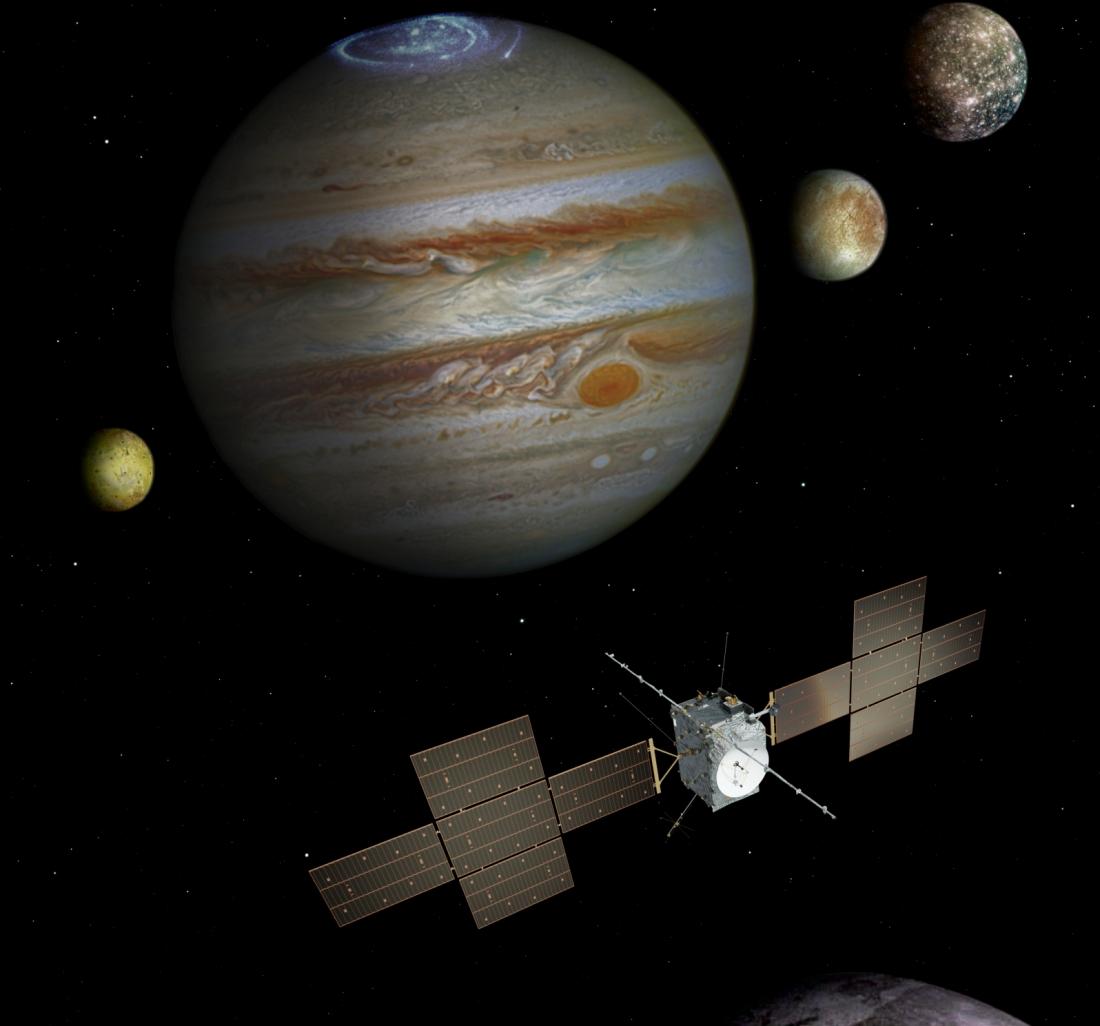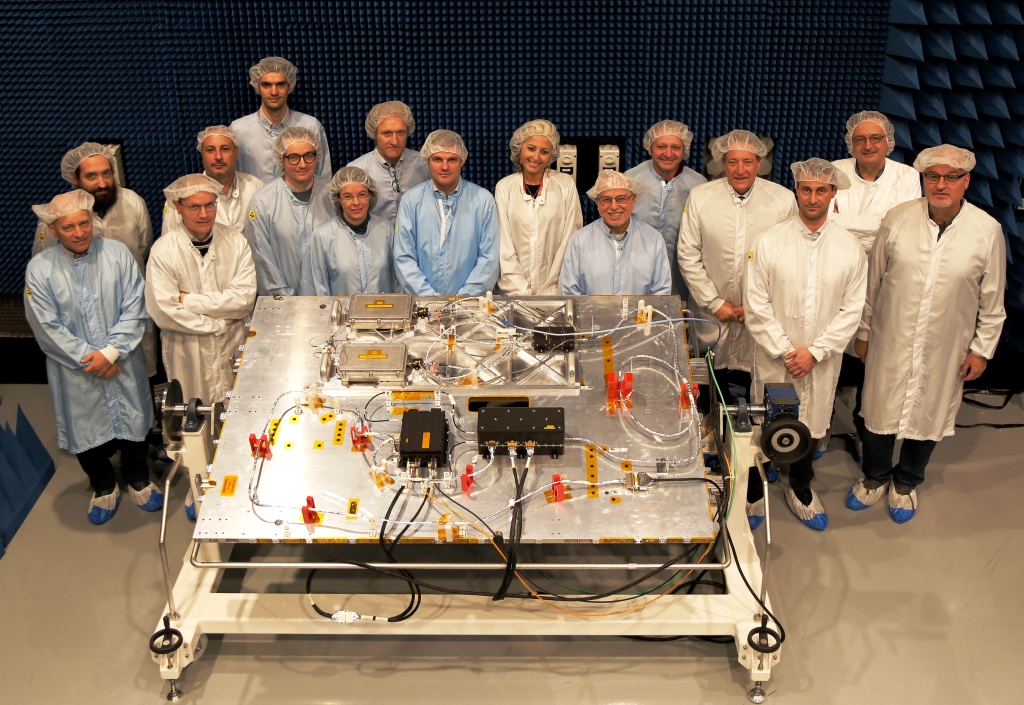Investigating Jupiter with KaT, a state-of-the-art transponder
Thales Alenia Space has just delivered a Ka-band transponder (KaT) to the European Space Agency (ESA) for integration in the 3GM, or Gravity & Geophysics of Jupiter and Galilean Moons radio package. The 3GM is one of the instruments on Europe’s upcoming JUICE mission (JUpiter ICy moons Explorer), enabling scientists to study the gravity field at Ganymede, the extent of the internal oceans on the icy moons, and the structure of the neutral atmosphere and ionosphere of Jupiter and its moons. KaT provides highly accurate two-way range and range-rate measurements at Ka band. In turn, the gravity experiment relies on the Ka-band radio link to help unveil the interior structure of Ganymede, in particular inferring the size of the subsurface ocean by measuring the moon's gravity field and tidal response.
Our engineers and technicians have continued critical operations for our customers in recent months despite the coronavirus pandemic, while complying with all health and safety measures.
Looking into Jupiter and its icy moons

Scheduled for launch in 2022 and expected to reach Jupiter in October 2029, the JUICE spacecraft is designed and built by Airbus Defence and Space as prime contractor. An ESA mission, with a major contribution from the Italian space agency ASI, JUICE will study Jupiter and its three large, icy moons: Ganymede, Callisto and Europa.
Discovered by Galileo in 1610, the moons hold out fascinating possibilities because they’re thought to have vast oceans of water beneath their surfaces, making them potentially habitable environments. The mission will explore the surface and inner layers of the moons, investigating the conditions for the emergence of life. Thales Alenia Space’s contribution also includes the Deep Space Transponders (DST) for telemetry, tracking and command, and the Radar for Icy Moons Exploration (RIME), one of the 10 instruments.

RIME (photo of the team in January 2020) is considered a key to mission success, because of its ability to directly identify and map the internal structure of the ice layers. Using a 16-meter antenna, which is provided by Space Tech GmbH under contract to Airbus Defense and Space, and working at a central frequency of 9 MHz, RIME is designed to penetrate the ice surface down to a depth of 9 kilometers, with vertical resolution of up to 30 meters in ice, to help determine the subsurface structure of the three moons’ oceans. ASI is funding radar development, including a contribution from NASA, with the University of Trento in charge of scientific aspects.
Technology Heritage
Venus, Mars, Mercury, Saturn, the Moon, Jupiter, asteroids and comets… Thales Alenia Space’s technology is a critical part of deep space probes such as Mars Express and the ExoMars Trace Gas Orbiter (currently in orbit around Mars); Venus Express; Cassini-Huygens (the Cassini probe completed its mission to Saturn in 2017 by burning up in the atmosphere); Rosetta, which has gathered data to characterize this comet’s environment and nucleus, thus providing clues to the origin of the Solar System; Gaia, which is mapping the Milky Way with unprecedented accuracy; Lisa Pathfinder, which paved the way for in-flight testing of gravitational wave detection; BepiColombo, now on its way to Mercury; and Solar Orbiter, which will take a close look at the Sun, in a way previously thought impossible.
All these spacecraft communicate with Earth from a distance of several Astronomical Units (millions of km) (ndt: AU = mean distance from Earth to Sun, 149.6 million km), while relying on the compact Deep Space Transponder from Thales Alenia Space, which combines state-of-art microwave technology.
KaT was designed and developed by Thales Alenia Space in Italy in cooperation with the University of Rome-La Sapienza prof. Luciano Iess, and with ASI funding, to perform a radio-science experiment. This concept draws on our experience with the Cassini mission. The Ka-band Translator was the first to use a radio-link in the Ka band (32–34 GHz), thus offering outstanding frequency stability among other advantages. This instrument enabled the Italian scientific community to verify the relativistic deflection of a radio signal fifty times more accurately than any made previously (see the article in Nature, September 25, 2003). In 2008 we supplied a KaT for NASA’s Juno mission. The KaT used on BepiColombo went even further, because it was the first radio-science device to employ an innovative broadband (50 MHz) pseudo-noise ranging technique that provided two-way range measurements to an accuracy of within a centimeter at 50 million kilometers from Earth (see “Report on first in-flight data of BepiColombo’s Mercury Orbiter Radio-science Experiment”, IEEE Transactions on Aerospace and Electronic Systems, July 2020).
The novel KaT designed and developed for JUICE (see photo) represents a further upgrade, since radiation-hardening hasbeen increased to cope with the harsh environment around Jupiter.

Massimo Comparini commented: "Our heritage in radio-science technologies and deep space communications is unrivaled. These achievements are the result of a long standing scientific and industrial tradition driven by extensive skills, expertise and investments that have brought us to the forefront of this demanding field. My best Kudos to everybody involved in the development of this sophisticated equipment, achieving this remarkable latest milestone and sustaining our excellence in this area year after year, mission after mission".